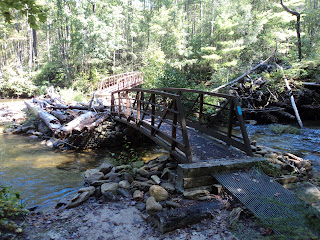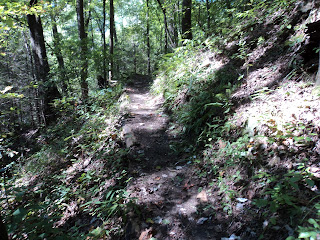Hike Location: Bad Creek Foothills Trail Access
Geographic Location: north of Salem , SC (35.01231, -82.99905)
Length: 6 miles
Difficulty: 6,10/10 (Difficult)
Date Hiked: September 2012, April 2021
Overview: An out-and-back with one difficult section to the tallest waterfall in the east.
Hike Route Map: https://www.mappedometer.com/?maproute=724135
Hike Video:
Directions to the trailhead: From the intersection of SR 11 and SR 130, take SR 130 north 10.2 miles to the Bad Creek Access Road . Turn right on the access road. Drive the paved access road 2.4 miles steeply downhill, turning left once as you follow signs for the Foothills Trail. Park in the large blacktop Foothills Trail Access parking lot.
The hike: Gashing into the land along the South Carolina-North Carolina border, the Jocassee Gorges comprise 5 steep, rugged ravines around rivers that form major tributaries of man-made Lake Jocassee. The lake and the gorges are used by Duke Energy for power generation. On point, the final road you drove down on your way to the trailhead is the access road for Duke Energy’s Bad Creek Pumped Storage facility. Water is pumped into the facility at times of low electricity demand and then released through turbines to generate electricity at times of high demand.
Duke Energy also owns and manages this trailhead and about half of the trail used on this hike; the other half passes through the Nantahala National Forest of North Carolina. Thus, while the trailhead for this hike is in South Carolina , Upper Whitewater Falls North Carolina . In addition to the thrill of hiking across a state line, you get to enjoy the aptly named Whitewater River
Before describing the hike, I should mention that if all you want to do is see the waterfall, there is a far easier way to do it than taking this hike. If you continue driving north on South Carolina SR 130 past Bad Creek Access Road, you will quickly enter North Carolina and come to a signed national forest parking area on the right. From this parking area, it is only a 0.2 mile walk, mostly on wooden steps, to the waterfall viewing platform reached in 3 miles here.
 |
| Bad Creek Access Foothills Trailhead |
The trail curves right at a metal stake bearing blue paint to leave the disturbed area and enter the forest. The forest is a mixture of pine and deciduous trees, most numerously maple trees. The largest and smallest trees are pines while the deciduous trees occupy the middle. The trail tops a small rise and then descends to the Whitewater River
 |
| Descending toward Whitewater River |
 |
| Twin bridges across Whitewater River |
 |
| Intersecting the Foothills Trail |
The white-blazed Foothills Trail begins on a wide, level course with cascading Whitewater River to your left. The splashing of the aptly-named river will be your near-constant companion for the rest of the hike. The trail passes through what would appear to be an established campsite except for a sign that says, “No camping.”
 |
| Steps around rock outcrop |
 |
| Side hill on Foothills Trail |
On the other side of Corbin Creek Whitewater River
 |
| Whitewater River bridge between boulders |
At 2.9 miles, the Foothills Trail exits left while the trail to the waterfall overlook switches back to the right. After climbing one final set of wooden steps, you reach the main overlook for Whitewater Falls. What a sight this is! The plentiful, clear water of the Whitewater River tumbles 400 to 600 feet (it is hard to measure waterfalls this large) with two large drops, one at the top and one at the bottom. Green pine trees and grey rock outcrops surround the falls, framing them perfectly. You have earned this view, so take some time and have a trail snack while savoring the rewards.
 |
| Upper Whitewater Falls |
Hiking on the Foothills Trail this weekend. Thanks for the detailed info!
ReplyDeleteYou're welcome. You should have a great time out there this weekend!
Delete